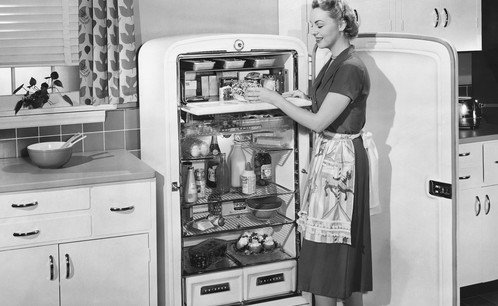Refrigerators occupy a special place among the major appliances in our homes. A refrigerator is the largest home appliance that operates around-the-clock every day. The good news is that refrigerator energy efficiency has increased dramatically in recent years. With most of us keeping refrigerators for 10 to 13 years, it takes a while for these improvements to find their way into our homes.
Increased Energy Efficiency
New energy efficiency standards for refrigerators took effect in 2014. Units meeting the new standards typically use between 400 and 600 kWh per year. This is around 35% of what 1990-vintage refrigerators used. Most of the improvements have come from using high-efficiency compressors, tighter door seals, and better insulation technologies.
Insulation has always been a challenge with refrigerators. Kitchen cabinet configurations usually limit the overall dimensions of the refrigerator. Increasing insulation typically meant increasing the wall thickness and decreasing storage capacity. Manufacturers are now using vacuum insulation technologies (similar to a thermos) to increase the overcome this problem.
Refrigerator Configuration
If you happen to be barefoot when you open your refrigerator door, you can feel the cold air spilling out on the floor. You spent good money creating that chilled air and now it has escaped. The best design to combat this problem is a chest-style refrigerator. The problem with this design is that most kitchens do not have room for them and the benefits are usually lost with the time you spend digging around looking for what you need.
Most of us choose one the three main upright refrigerator configurations: top freezer, side-by-side, or bottom freezer. In general, models with the freezer on top are the most energy efficient. Side-by-side models are typically the biggest energy users. Models with the freezer on the bottom tend to fall somewhere between the other two in terms of energy usage.
Staying Organized
With the new energy efficiency standards, there are no wrong choices. Any model or configuration is far better than what was available even five years ago. However, it helps to look at energy efficiency in terms of how you use the refrigerator.
The compressor creates chilled air that cools the refrigerated space. Everything is stable and happy until you open the door and upset the balance. The goal is to minimize your impact on things. In the case of a traditional top freezer single door model, opening the main door and rummaging around for a jar of mustard is not very efficient. The most energy efficient refrigerator in the market is no match for a teenager holding door open for several minutes looking for grazing material.
Organizing the items in your refrigerator minimizes the amount of time is open. For most of us, this is a goal rather than a reality. Some refrigerators, like the French door style with cooling drawers, can force a bit of organization on us. Instead of opening the entire refrigerated compartment, you only open one drawer to retrieve an item. The loss of chilled air (and energy) is limited to just that drawer rather than the entire compartment.
Additional Energy-Saving Tips
There is no shortage of online advice or refrigerator model comparison guides. Here are some of the best suggestions that will make the biggest impact on your electricity bill.
- Keep the refrigerator compartment set between 35 and 38 degrees F. The freezer compartment should be around 0 to 5 degrees F.
- Do not pack foods too tightly inside the refrigerator. This allows air to flow around each item and is more efficient at keeping everything at the desired temperature.
- While you should not buy a refrigerator with more storage space than you need, it is cheaper to have a single larger fridge in the house than keeping a second one in the garage or basement.
- Leave a few inches between the wall and refrigerator. This allows air circulation behind the fridge and allows ventilation of the compressor waste heat.
Keep these suggestions in mind and enjoy the energy savings!


